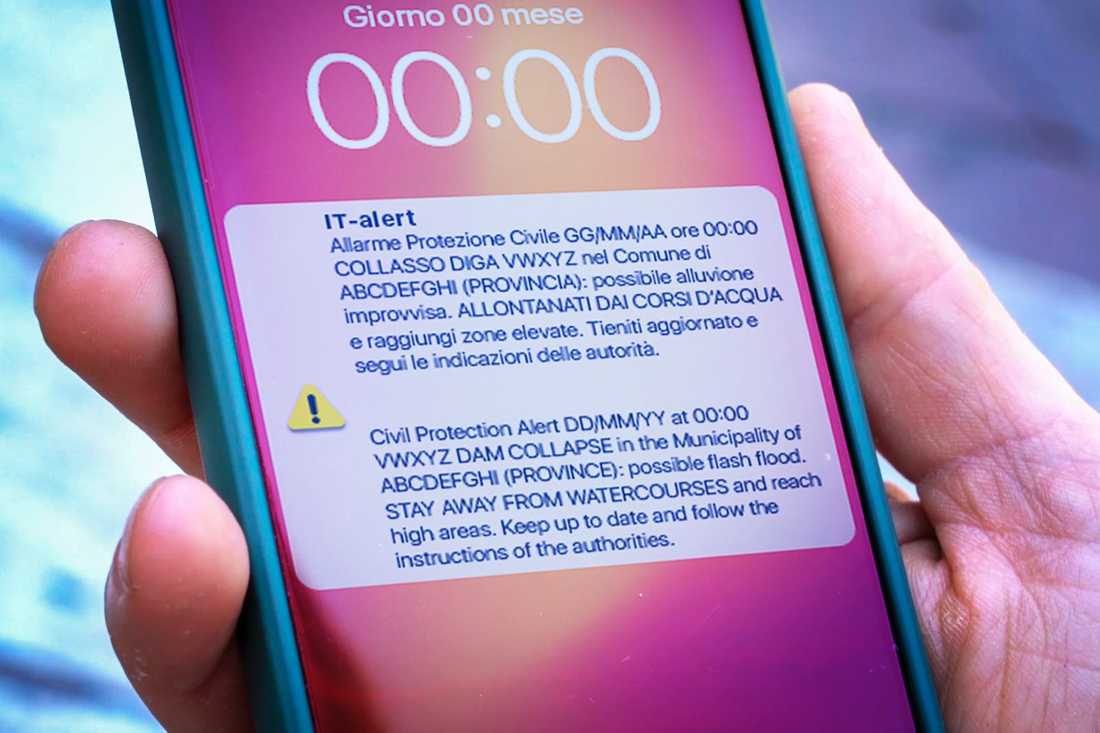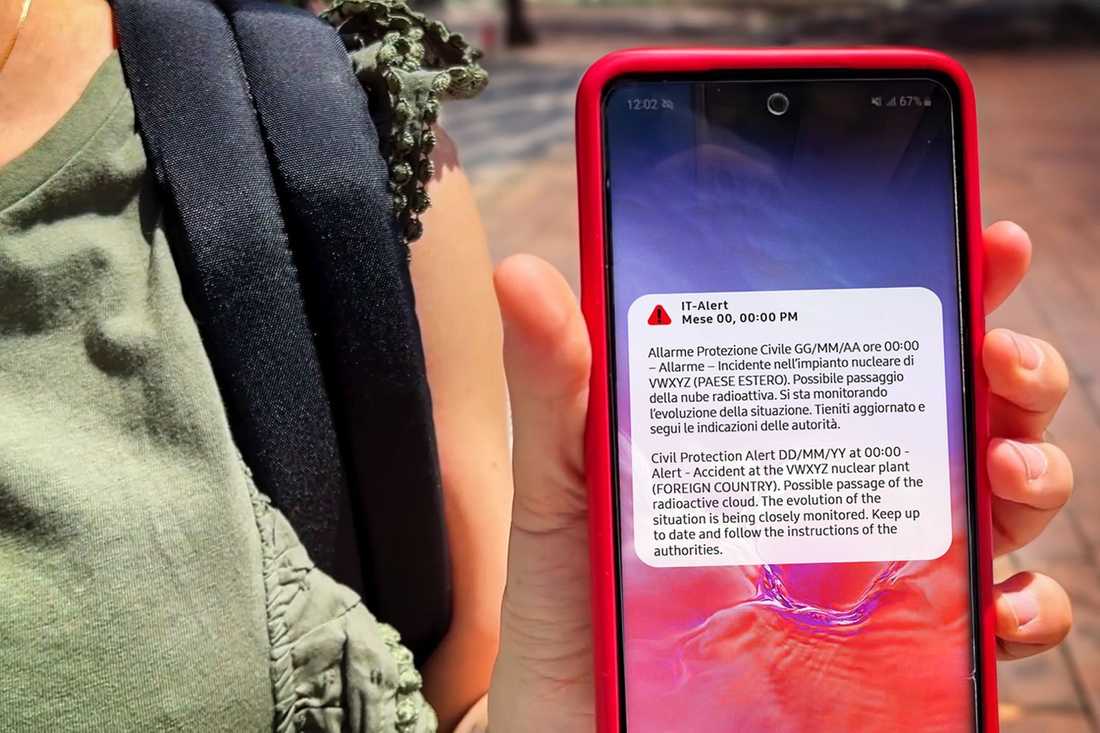IT-alert: testing on specific risks in 12 regions from January 22 to 26
Collapse of large dams, major accident at industrial facilities, and nuclear accident are the tested risk scenarios. Latest update: January 22, 2024

The IT-alert experimentation continues with the phase focused on specific risk scenarios and small and limited portions of the territory.
The first testing round of 2024 will occur from January 22 to 26, and IT-alert notifications will be sent to part of the territories of 12 regions: Abruzzo, Basilicata, Calabria, Campania, Emilia-Romagna, Friuli-Venezia Giulia, Piedmont, Sardinia, Sicily, Tuscany, Valle D'Aosta and the Autonomous Province of Bolzano.
The risk scenarios will be three:
▪ Collapse of large dams in Campania, Sicily, Valle D'Aosta and the Autonomous Province of Bolzano;
▪ Major accident at industrial facilities subject to the Seveso Directive in Abruzzo, Basilicata, Calabria, Campania, Emilia-Romagna, Friuli-Venezia Giulia, Sardinia, and Tuscany;
▪ Nuclear accident in Piedmont.
The testing activity has a two-fold purpose: to test IT-alert on small and limited portions of the territory and to take a step forward in familiarizing with the reception of the notification with text tailored to the risk and the affected site. This is all part of a broader process of getting closer to the potential implementation of the national public warning system, as provided for in the Directive of February 7, 2023.
For the major accident at industrial facilities, the notification text reads as follows:
TEST TEST This is a TEST MESSAGE from IT-alert. We are SIMULATING an industrial accident in the area where you are. To learn what message you will receive in case of real danger from an industrial accident, go to www.it-alert.gov.it/en TEST TEST
For the collapse of large dams, the notification text will read as follows:
TEST TEST This is a TEST MESSAGE from IT-alert. We are SIMULATING a dam collapse in the area where you are. To learn what message you will receive in case of real danger from a dam collapse, go to www.it-alert.gov.it/en TEST TEST
Finally, for the nuclear accident scenario, the notification text will read as follows:
TEST TEST This is a TEST MESSAGE from IT-alert. We are SIMULATING a nuclear accident in a plant located in a foreign country with potential repercussions in the area where you are. To learn what message you will receive in case of real danger from a radiological and nuclear accident, go to www.it-alert.gov.it/en TEST TEST
During the days of the testing, from the website's homepage, there will be access to a dedicated page where it will be possible to view the text of the message that citizens would receive in case of real danger for that specific risk and the case-specific information. As in the previous tests, on the homepage and the dedicated page, there will also be a link to the survey that the people in the involved territories will be invited to fill out to help implement the system. Those in the area covered by the test that will not receive any IT-alert notification will still be able to fill it out to report this deficiency.
The notification will arrive on the switched-on and connected cell phones of those in the target areas according to the following schedule:
January 22, 12:00 p.m.
Nuclear accident
▪ Piedmont Region - Metropolitan City of Turin
January 23, 2:30 p.m.
Major accident at industrial facilities
▪ Tuscany Region - TOSCOCHIMICA, Prato (PO) and Campi Bisenzio (FI)
January 24, 12:00 p.m.
Major accident at industrial facilities
▪ Calabria Region - BUTANGAS, Montalto Uffugo, Luzzi, Rende, Rose (CS)
▪ Campania Region - GAROLLA S.R.L., Naples
▪ Emilia-Romagna Region - SCAM S.P.A., Modena
▪ Sardinia Region - FIAMMA 2000 S.P.A., Serramanna (SU) and Villasor (SU)
January 25, 12:00 p.m.
Major accident at industrial facilities
▪ Basilicata Region - ENI S.P.A., Viggiano, Grumento Nova (PZ)
▪ Friuli-Venezia Giulia Region - RIR-GALA LOGISTICA S.R.L., Visco, Aiello del Friuli, Palmanova, San Vito al Torre (UD)
Collapse of large dams
▪ Campania Region - Presenzano Dam - Amorosi, Dugenta, Faicchio, Limatola, Melizzano, Puglianello (BN); Ailano, Alife, Alvignano, Baia e Latina, Bellona, Caiazzo, Capua, Castel Campagnano, Castel Morrone, Dragoni, Gioia Sannitica, Piana di Monte Verna, Pietravairano, Pontelatone, Pratella, Presenzano, Raviscanina, Ruviano, Sant'Angelo d'Alife, and Vairano Patenora (CE)
▪ Autonomous Province of Bolzano - Monguelfo Dam - Brunico, Chienes, Perca, Rasun-Anterselva, San Lorenzo di Sebato, Valdaora, Vandoies e Rodengo.
January 26, 12:00 p.m
Major accident at industrial facilities
▪ Abruzzo Region - GPL SODIFA S.R.L., L'Aquila
Collapse of large dams
▪ Sicily Region - Ancipa Dam - Centuripe, Troina (EN); Cesarò, San Teodoro (ME); Adrano, Belpasso, Biancavilla, Bronte, Catania, Motta, Paternò, Randazzo, Sant'Anastasia (CT)
▪ Valle D'Aosta Region - Beauregard Dam - Arvier, Valgrisenche and Villeneuve
Test dates may be subject to change if regional civil protection systems are involved in activities for any ongoing meteo-hydro alerts or emergencies.
Major accident means an event such as a significant emission, fire, or explosion due to uncontrolled developments occurring during the operation of an industrial facility classified as a major-accident hazard by Legislative Decree No. 105 of June 26, 2015 - Implementation of Directive 2012/18/UE of the European Parliament and of the Council on the control of major accident hazards involving dangerous substances, and which results in an immediate or delayed major hazard for human health and the environment, either inside or outside the facility, and in which one or more hazardous substances are involved.
Each industrial facility must have an External emergency plan (EEP) containing damage mitigation measures outside the facility and an Internal Emergency Plan (IEP), including damage mitigation measures inside the facility.
IT-alert would be activated for possible accident scenarios affecting the facility.

In case of real danger from a major accident at an industrial facility, cell phone users in the areas near the affected facilities will receive such an IT-alert message:
Civil Protection Alert DD/MM/YY at 00:00 - Accident at the XYZ industrial facility involving hazardous substances in the Municipality of XYZ (PROVINCE). FIND INDOOR SHELTER AND DO NOT GO NEAR the facility (E04). Keep up to date and follow the instructions of the authorities.
However, there may be devices present in areas affected by the emergency that will not receive the message. This is caused by one of the limits of cell-broadcast technology: the impossibility of perfectly overlaying the area potentially affected by the emergency with the area covered by the antennas of the telephone operators used to send the messages.
"Collapse of a large dam" refers to the collapse of the dam structure itself or the occurrence of damages to the dam or landslides that lead to the uncontrolled release of water, such as to reasonably assume the occurrence of a catastrophic event, which generally causes a flood wave and the subsequent flooding of downstream areas. Large dams are regulated by the Directive of the President of the Council of Ministers of July 8, 2014, on "Operational guidelines concerning civil protection activities within basins where large dams are present."
When a risk related to the structural strength of a large dam occurs, it is referred to as "dam risk," which entails four alert phases (pre-alert, reinforced alert, danger, and collapse).
Each dam is required to have a Civil Protection Document (DP), which defines the specific conditions for the activation of the civil protection system, communications, and technical-administrative procedures to be implemented in case of risk, and a Dam Emergency Plan (DEP), which outlines the areas potentially affected by the flood wave, operational strategies, and the intervention model to face the emergency.
IT-alert would be activated in case of collapse of a large dam, that is, a retaining structure exceeding 15 meters in height or resulting in a reservoir volume exceeding 1,000,000 cubic meters.

In case of real danger from a large dam collapse, cell phones in the municipalities potentially affected by the flood wave will receive such an IT-alert message:
Civil Protection Alert DD/MM/YY at 00:00 - XYZ DAM COLLAPSE in the Municipality of XYZ (PROVINCE): possible flash flood. STAY AWAY FROM WATERCOURSES and reach high areas. Keep up to date and follow the instructions of the authorities.
However, there may be devices present in areas affected by the emergency that will not receive the message. This is caused by one of the limits of cell-broadcast technology: the impossibility of perfectly overlaying the area potentially affected by the emergency with the area covered by the antennas of the telephone operators used to send the messages.
"Nuclear accident" refers to any accidental event involving significant consequences in terms of radiation protection or nuclear safety.
There are no operating nuclear plants in Italy. Other countries, however, some of them neighboring Italy, have active nuclear plants for energy production. Therefore, to deal with possible accidents beyond national borders, the National Plan for the management of radiological and nuclear emergencies was adopted, which considers three accident scenarios based on how far the event occurs from national borders.
The scenario considered by the IT-alert national public warning system is the one resulting from a nuclear accident within 200 kilometers from the Italian border, corresponding to the "ALARM" operational phase.

In case of real danger from a nuclear accident, cell phones in the affected municipalities will receive such an IT-alert message:
Civil Protection Alert DD/MM/YY at 00:00 - Alert - Accident at the XYZ nuclear plant (FOREIGN COUNTRY). Possible passage of the radioactive cloud. The evolution of the situation is being closely monitored. Keep up to date and follow the instructions of the authorities.
However, there may be devices present in areas affected by the emergency that will not receive the message. This is caused by one of the limits of cell-broadcast technology: the impossibility of perfectly overlaying the area potentially affected by the emergency with the area covered by the antennas of the telephone operators used to send the messages.